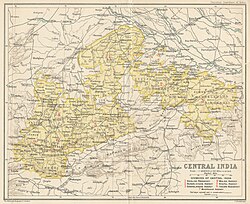| Bhopawar Agency | |||||||||
|---|---|---|---|---|---|---|---|---|---|
| Sub-agency of the Central India Agency | |||||||||
| 1882–1937 | |||||||||
 Map of the Central India Agency with the Bhopawar Agency located at its western end | |||||||||
| Area | |||||||||
• 1901 | 19,902 km2 (7,684 sq mi) | ||||||||
| Population | |||||||||
• 1901 | 547,546 | ||||||||
| History | |||||||||
| 1882 | |||||||||
• Merger into Malwa Agency | 1937 | ||||||||
| |||||||||
| This article incorporates text from a publication now in the public domain: Chisholm, Hugh, ed. (1911). "Bhopawar". Encyclopædia Britannica (11th ed.). Cambridge University Press. | |||||||||
Bhopawar Agency was a sub-agency of the Central India Agency in British India with the headquarters at the town of Bhopawar, so the name. Bhopawar Agency was created in 1882 from a number of princely states in the Western Nimar and Southern Malwa regions of Central India belonging to the former Bhil Agency and Bhil Sub-agency with the capitals at Bhopawar and Manpur. [1] The agency was named after Bhopawar, a village in Sardarpur tehsil, Dhar District of present-day Madhya Pradesh state. Manpur remained a strictly British territory.
Contents
- History
- Princely states and their feudatory estates
- Salute States
- Non-salute states
- References
- External links and Sources
| Princely state |
|---|
| Individual residencies |
| Agencies |
|
| Lists |
The other chief towns of this region were: Badnawar, Kukshi, Manawar and Sardarpur, Chadawad Estate, Dattigaon. The mighty Vindhya and Satpura ranges crossed the territory of the agency roughly from east to west, with the fertile valley of the Narmada River lying between them. The agency also included the "Bhil Country", inhabited by the Bhil people. [2]
